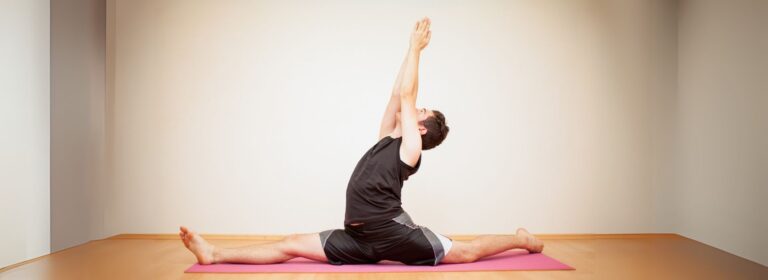Yoga Practice Name
Hanumanasana (हनुमानासन)


Hanumanasana (हनुमानासन)
Monkey Pose
Hanumanasana is an advanced yoga asana that resembles a full front split, symbolizing the powerful leap of Lord Hanuman. This pose stretches the hamstrings, hip flexors, and groin, while also cultivating balance, courage, and devotional focus. It is both a physical and symbolic expression of strength and flexibility.
1. Start in a Low Lunge (Anjaneyasana): – From Downward-Facing Dog or standing, step your right foot forward between your hands. Lower your left knee to the mat, with the top of the foot resting on the floor.
2. Begin Extending the Front Leg: – Gently slide your right foot forward, straightening the leg as much as possible. At the same time, slide your left leg back, keeping the hips squared and facing forward.
3. Use Props if Needed: – Place yoga blocks under both hands to support your balance. You can also place a blanket or bolster under the pelvis if the hips don’t reach the floor.
4. Lower Into Full Hanumanasana: – Gradually descend into the full split, ensuring no pain in the hamstrings or groin. Keep the spine tall, chest open, and hands at the heart center or raised overhead (Anjali Mudra).
5. Breathe and Hold: – Hold the pose for 20–30 seconds (or longer with experience), breathing deeply and steadily.
6. To Release: – Press into your hands, slowly bend the front leg, and retract the legs back into a lunge or Downward Dog. Repeat on the opposite side.
1. Deep Stretch for Hamstrings and Hip Flexors – Provides an intense stretch to the hamstrings, groin, quadriceps, and hip flexors, increasing flexibility.
2. Improves Balance and Coordination – Holding this asymmetrical and low-to-the-ground pose enhances core strength and neuromuscular control.
3. Increases Lower Body Mobility – Opens up the pelvic region and lengthens muscles in the legs, improving range of motion.
4. Builds Strength and Stability – Engages the thighs, glutes, and core muscles, promoting muscular integrity along with flexibility.
5. Stimulates Abdominal Organs – The pose gently massages internal organs, aiding digestion and improving circulation in the pelvic region.
6. Improves Posture and Body Awareness – Encourages spinal extension, shoulder alignment, and mindful engagement of the entire body.
7. Symbolizes Devotion and Courage – Hanumanasana honors the leap of faith made by Lord Hanuman, evoking a sense of inner strength, focus, and devotional discipline.
8. Enhances Athletic Performance – Particularly beneficial for dancers, martial artists, runners, and gymnasts due to its focus on flexibility and leg strength.
9. Prepares the Body for Advanced Practices – Acts as a gateway pose for more advanced postures involving the legs, hips, and pelvis.
1.Ardha Hanumanasana, 2.Anjaneyasana, 3.Supta Padangusthasana, 4.Utthita Hasta Padangusthasana, 5.Samakonasana, 6.Janu Sirsasana, 7.Eka Pada Rajakapotasana
1. Thorough Warm-Up is Essential – Always begin with hamstring, hip, and quad stretches (e.g., Low Lunge, Ardha Hanumanasana). Never attempt Hanumanasana with cold or tight muscles.
2. Use Props to Support the Journey – Yoga blocks, bolsters, and blankets under the pelvis or hands help maintain alignment and prevent injury. Encourage slow and steady progress using props as bridges.
3. Alignment Over Depth – Focus on keeping the hips square to the front, spine upright, and knees protected. Avoid twisting or collapsing into the lower back or groin.
4. Engage Muscles to Protect Joints – Actively engage the thighs and core muscles to avoid overstretching and build functional flexibility.
5. Stay Mindful and Patient – This pose teaches devotion and discipline. Progress may be slow—approach it with consistency, awareness, and gratitude.